Fighting for Freedom |
|
| His Truth Is Marching On | |
|
Julia Ward Howe, a white abolitionist, felt that there should be more positive lyrics to the tune of "John Brown's Body Lies A Moldering in the Grave," so she wrote the words to the "Battle Hymn of the Republic," to be used with the same tune. Howe's hus band had entertained John Brown in their home. The Supervisory Committee for Recruiting Colored Regiments published this broadside with the lyrics. |

Julia Ward Howe. "Battle Hymn of the Republic." Published by the Supervisory Committee for Recruiting Colored Regiments. Broadside. Rare Book and Special Collections. (4-20) |
| An African American Medal of Honor Winner | ||
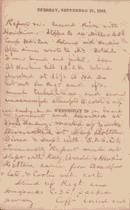 Christian A. Fleetwood. Diary, September 24, 1864. Holograph manuscript. Christian A. Fleetwood Papers, Manuscript Division. (4-14) |
These pages of Christian Fleetwood's diary detail his actions during a battle at Chaffin's farm near Richmond, Virginia, on September 29, 1864, which led to his receipt of the Congressional Medal of Honor. Fleetwood was one of fourteen African American men who received the medal for meritorious service during the war. |
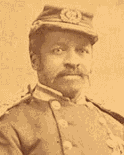
Albumen print, carte de visite, 1884. Manuscript Division. (4-15) |
|
Fleetwood's regiment, the 4th U. S. Colored Infantry, saw action in Virginia. His diary also documents North Carolina campaigns and President Lincoln's visit to the front lines in June 1864. |
||
| U.S. Colored Troops--Flags | |

Carte de visite. Gladstone Collection, Prints and Photographs Division. Reproduction Number: LC-USZC4-6156 (4-7) |
In many of the stylized images of African Americans during the 1800s, freedom and justice are personified as a statuesque white woman in flowing robes. Behind the soldier in this image, liberated slaves are celebrating his accomplishments. |
| U.S. Colored Troops--Wounded in Action | |
|
Although the United States Colored Troops did not see as much action as many of them wanted to, they did participate in many skirmishes and major battles. After an unspecified battle in Virginia, probably in 1864, these wounded soldiers recuperated at Aikens Landing, a site used mainly for supplies. Taunted by many detractors, African American soldiers were eager to demonstrate that they could be courageous under fire. Despite problems getting paid, lower wages than white soldiers when they finally were paid, segregated units, and high ranks for whites only, the U.S. Colored Troops displayed a tenacious loyalty to the Union cause. |
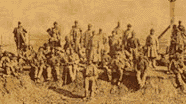
Wounded Colored Troops at Aikens Landing. Stereograph. Gladstone Collection, Prints and Photographs Division. Reproduction Number: LC-USZC4-6157 (4-8) |
| African Americans at Sea | |

Carte de visite. Gladstone Collection, Prints and Photographs Division. Reproduction Number: LC-USZC4-6159 (4-10) |
This stereograph shows an African American, one of thousands of blacks who served at sea during the Civil War. The most famous of these was the Honorable Robert Smalls, later a Reconstruction congressman, who became the captain of a Confederate vessel that he commandeered and sailed into Union lines. Service records for over eighteen thousand African American Civil War seamen have now been identified by the Naval Historical Center at the Washington, D. C., Navy Yard. |
| Emancipation Celebration | |
|
The District of Columbia Emancipation Act, passed on April 19, 1862, abolished slavery in the nation's capital and provided up to $300 compensation to owners for each freed slave. The African American population in the District regularly celebrated this Emancipation Day with bands, parades, sermons and speeches. This illustration from Harper's Weekly depicts the fourth anniversary of the District's Emancipation Act. On April 19, 1866, African American citizens of Washington, D.C., staged a huge celebration. Approximately 5,000 people marched up Pennsylvania Avenue, past 10,000 cheering spectators, to Franklin Square for religious services and speeches by prominent politicians. Two of the many black regiments that had gained distinction in the Civil War led the procession. |
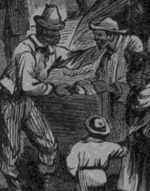
F. Deilman. Celebration of the abolition of slavery in the District of Columbia, by the colored people in Washington, April 19, 1866. Wood engraving. From Harper's Weekly, May 12, 1866. Copyprint. Prints and Photographs Division. Reproduction Number: LC-USZ62-33937 (4-11) |
| Forever Free | |

Richmond, Virginia, 1865. Copyprint. Prints and Photographs Division. Reproduction Number: LC-B8171-3368 (4-3) |
The Emancipation Proclamation declared that all slaves in the Confederate states were "forever free." Free blacks, forming their own communities even during the slavery era, owned homes, businesses, and churches like this one. This group of African Americans is standing before a church on Broad Street in Richmond after the city was taken by Union soldiers in 1865. |
"Behold the Shackles Fall" |
|
| Sojourner Truth Ministers to the Colored Troops | |
|
Abolitionist and orator Sojourner Truth, who was illiterate, engaged her friend Euphemia Cockrane to write this letter to Mary R. Gale. Truth explains that she is communicating from Detroit, because she traveled there from Battle Creek to bring a donatio n of "good things" from the people of Michigan to the African American troops. |
|
|
Truth states that when warmer weather comes she will go to visit the freedmen. She exults that "This is a great and glorious day!" and continues: It is good to live in it & behold the shackles fall from the manacled limbs. Oh if I were ten years younger I would go down with these soldiers here & be the Mother of the Regiment! |

Sojourner Truth (written by Cockrane) to Mary Gale, February 25, 1864. Letter concerning the emancipation of her children and her son's Civil War service. Manuscript Division. (4-13) |
| The Spirituals: Early Publication | |
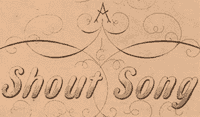
Boston: Oliver Ditson, 1864. Music Division. (4-18) |
The long journey of the African American spiritual begins in slavery. It first emerges into print during the Civil War, when "contrabands" sang their songs to Northern musicians who transcribed and harmonized the melodies. "Down in the Lonesome Valley" and "Go Down, Moses" were two of the spirituals actually published with music during the Civil War. The sheet music for "Down in the Lonesome Valley" published four verses of the song as sung by the freedmen of Port Royal, with some additions written by the compiler. Through publication, the spiritual had already begun its journey from being a purely African American genre to a musical form appreciated by a wide audience. |
| U.S. Colored Troops--Band | |
|
This view of the defenses of the Washington, D. C., area shows a group of twenty African American soldiers with musical instruments. Blacks served in various capacities in the Union army. At first Union leaders allowed no black men to be commissioned officers, but eventually they served as noncommissioned officers, doctors, and chaplains. The first African American field officer was Major Martin Delany. |
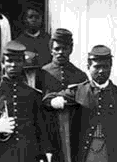
107th U.S. Colored Infantry Band at Fort Corcoran. Arlington, Virginia, November 1865. Copyprint. Prints and Photographs Division. Reproduction Number: LC-B8171-7861 (4-6) |
| Civil War Map of Virginia's Lower Peninsula | |
 Map of the Vicinity of Richmond and Part of the Peninsula. Department of Northern Virginia, Topographical Department, 1864. Baltimore: T. Swell Ball, 1891. Photolithograph facsimile reproduction. Geography and Map Division. (4-19) |
Prepared by Confederate engineers under the direction of Capt. Albert H. Campbell, this 1864 field map provides detailed geographic information about Richmond, Virginia, and vicinity, including that portion of the Lower Peninsula as far east as Williamsburg. Although this map's primary purpose was documenting military reconnaissance (especially topography), the transportation network, and fortifications, it also provides detailed information about the cultural settlement patterns. The most obvious settlement features depicted are the numerous plantations and farms. Depictions of these plantations include notations indicating the location of "quarters" and "overseer." But more remarkable are numerous references to free black settlements. |
| United States Colored Troops | |
|
Not until after the Emancipation Proclamation was in force as of January 1, 1863, did Union officers actively recruit African American soldiers, although some black men were unofficially part of segregated units in a few states. By the end of the Civil War, one out of every eight Union soldiers was a black man. This image is symbolic because the soldiers stand in front of a location where black slaves were held for auction, stripped, examined, and bought and sold before interested purchasers. |

William R. Pywell. Slave Pen in Alexandria, Va. [1862] Copyprint. Prints and Photographs Division. Reproduction Number: LC-B8171-2296 (4-2) |
|
Exhibit Sections: Slavery | Free Blacks | Abolition | Civil War | Reconstruction Booker T. Washington Era | WWI-Post War | The Depression-WWII | Civil Rights Era | |
African American Odyssey Introduction | Overview | Object List | Search